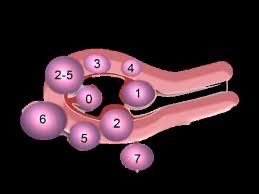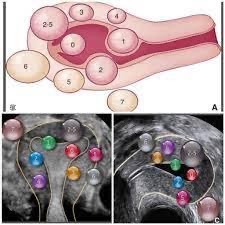Uterine fibroids: Everything you need to know
19 August 2024

What are uterine myomas?
Uterine myomas or fibroids are benign tumors that arise from the muscular layer of the uterus. They represent the most frequent cause of benign tumors in women, with an estimated prevalence of 70-80% throughout their lives.
Symptoms and characteristics
In 50% of cases, myomas are asymptomatic, but in others they can cause abnormal uterine bleeding, pelvic pain, feeling of uterine occupation and affect fertility. The symptoms depend on the size, location and number of myomas present.
Hormonal influence on fibroids
These tumors are sensitive to hormones, since they express receptors for estrogens and progesterone. Studies have shown an increase in the appearance of symptomatic fibroids during perimenopause, with a tendency to regression during menopause (Ulin et al., 2020). This has led to the fact that, traditionally, it is advisable to wait until menopause for clinical improvement. However, at present, waiting indefinitely for symptom relief may not be the most appropriate option for women with significant symptoms.
Treatment options
The treatment of fibroids depends on the symptoms and, above all, how they affect the woman's quality of life. There are different therapeutic alternatives, and a good understanding of the unique characteristics of each option is crucial to decide which is the best in each case. The choice must take into account the effectiveness in solving the problem, as well as the morbidity and the risk for the patient.
Medical treatment options are summarized in the table below from the article by Ulin et al published in the journal Menopause in 2020:

Surgical treatment
In addition to medical treatment, surgery is still the option with the best cure rates. The surgery is performed laparoscopically, removing the fibroids by morcellation inside a bag to increase safety. It is a well-tolerated procedure, with good post-surgical recovery and high satisfaction rates (Mercorio et al., 2023).
Myomas and infertility
For women who want to get pregnant and have fibroids, the need for treatment will depend on the size, number and location of the fibroids. Myomas are classified according to their location in:
Submucosal myomas: Type 0, 1, 2
Intramural myomas: Type 3, 4, 5
Subserous myomas: Type 6, 7
Cervical myomas: Type 8


In general, treatment should only be considered before pregnancy in those myomas that affect the endometrial cavity, deforming it or obstructing the tubes. In these cases, surgery is the treatment of choice, with better results than embolization or medical treatment (Carranza-Mamane et al., 2015). Surgical excision can be performed by means of hysteroscopy or laparoscopy, depending on the size of the myoma.
Myomas during pregnancy
The behavior of fibroids during pregnancy is very variable and difficult to predict. Generally, they tend to increase in size during the first trimester, while their evolution at the end of pregnancy and during the puerperium is more uncertain, with a tendency to decrease (Vitagliano et al., 2018).
References:
- Ulin M, Ali M, Chaudhry ZT, Al-Hendy A, Yang Q. Uterine fibroids in menopause and perimenopause. Menopause. 2020 Feb;27(2):238-242. doi: 10.1097/GME.0000000000001438. PMID: 31834160; PMCID: PMC6994343.
- Carranza-Mamane B, Havelock J, Hemmings R; REPRODUCTIVE ENDOCRINOLOGY AND INFERTILITY COMMITTEE; SPECIAL CONTRIBUTOR. The management of uterine fibroids in women with otherwise unexplained infertility. J Obstet Gynaecol Can. 2015 Mar;37(3):277-285. doi: 10.1016/S1701-2163(15)30318-2. PMID: 26001875.
- Mercorio A, Della Corte L, Boccia D, Palumbo M, Reppuccia S, Buonfantino C, Cuomo L, Borgo M, Zitiello A, De Angelis MC, Laganà AS, Bifulco G, Giampaolino P. Myomectomy in infertile women: More harm than good? Front Surg. 2023 Apr 17;10:1151901. doi: 10.3389/fsurg.2023.1151901. PMID: 37139194; PMCID: PMC10150951.
- Vitagliano A, Noventa M, Di Spiezio Sardo A, Saccone G, Gizzo S, Borgato S, Vitale SG, Laganà AS, Nardelli GB, Litta PS, Saccardi C. Uterine fibroid size modifications during pregnancy and puerperium: evidence from the first systematic review of literature. Arch Gynecol Obstet. 2018 Apr;297(4):823-835. doi: 10.1007/s00404-017-4621-4. Epub 2017 Dec 13. PMID: 29236171.